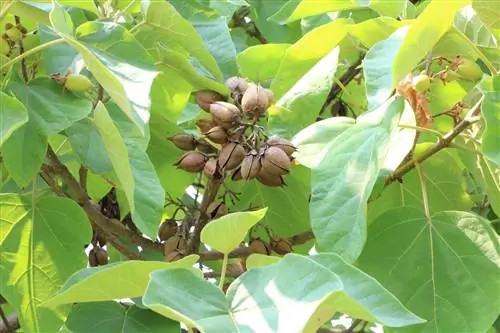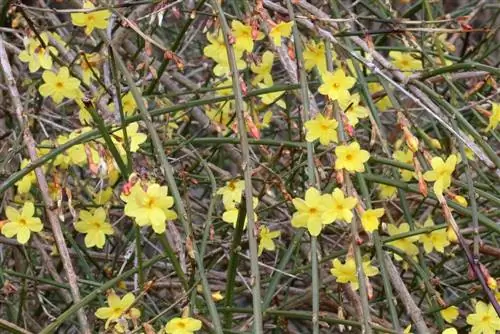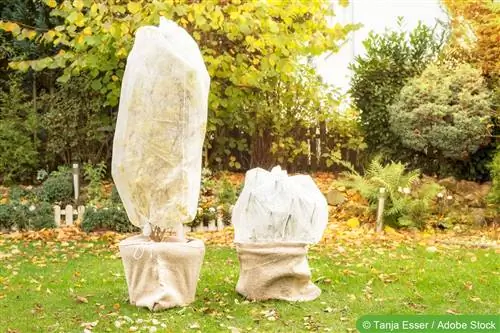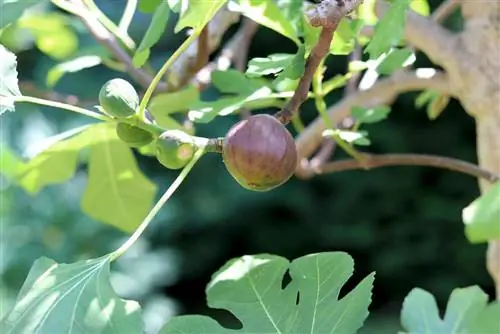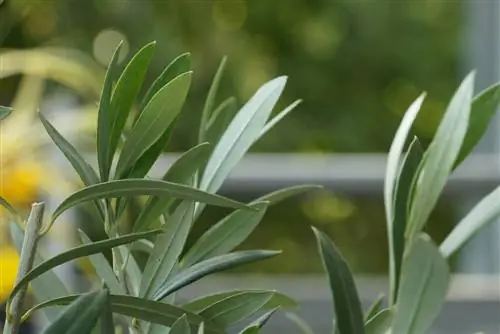- Author admin [email protected].
- Public 2023-12-17 03:39.
- Last modified 2025-01-24 12:45.
The bluebell tree is also known as the emperor tree and delights its owner with blue flowers that are grouped together in beautiful umbels. The flowers are followed by large heart-shaped leaves, so that this tree is a visual adornment for a long time of the year. In order for the bluebell tree to show its best side, it is important to follow a few tips regarding care and location.
Bluebell tree: choosing from the right perspective
So that you can actually experience the blossoms of the bluebell tree, a protected location with mild winters is necessary. Because the buds of the imperial tree develop at the end of autumn and cannot tolerate frost. In general, the bluebell tree, which comes from Asia, tolerates the winters in Central Europe very well, although younger trees are a little more sensitive and should have appropriate protection.
You should also pay attention to the sun when choosing the location, because the bluebell tree loves it sunny and thrives particularly well in appropriate places. The emperor tree also has certain demands on the soil, so it should have the following characteristics:
- air and water permeable
- very nutrient-rich
- dry to slightly moist
This type of tree does not tolerate waterlogging very well, which is why, if the substrate is suitable, you should either avoid planting a bluebell tree or at least put in drainage beforehand.
The space is an important feature of the location, as this fast-growing tree impresses with its expansive crown. If other trees and larger plants are too close to the bluebell tree, this can lead to reduced growth. Another special feature of the bluebell tree is the pleasant scent of the flowers, which are attractive to bumblebees and bees. This should be carefully considered when choosing a location, as not everyone likes to have visitors on their terrace.
Although the flowers are very attractive to bumblebees, when caring for them, care must be taken to ensure that the seeds of the bluebell tree spread very widely and that the plant reproduces itself vigorously. Since the herbaceous propagation quickly drives out other plants, you must ensure that new shoots are removed as early and completely as possible.
Bluebell Tree Care
When it comes to care for the imperial tree, special attention should be paid to the fact that it has a particularly strong tendency to self-sow. The seeds also show extreme growth and can reach a size of up to 2 meters in the first year - so you should remove the offspring as early as possible, otherwise the other plants would be driven away. This tree only needs to be watered in very hot and dry summers. If the soil becomes too dry, daily watering may be necessary.
Cut the bluebell tree correctly
Caring for the bluebell tree also includes proper pruning. Before the first autumn frost is the ideal time to thin out the treetop or carry out radical pruning. Radical pruning is necessary when the imperial tree becomes too large and all shoots at the top of the tree should be shortened to a length of approx. 1 to 2 cm. This radical cut can be carried out every year or every other year.
When thinning, however, only the following shoots are removed:
- dead
- damaged
- dry and
- too close.
A standard hedge trimmer can be used for this. The advantage of thinning is that the leaves after flowering reach an enormous size, giving the bluebell tree a particularly exotic look.
If the bluebell tree has shoots damaged by frost, it is best to remove them before spring. It is important to ensure that there are no further late frosts. Shoots damaged by frost must be removed. However, new shoots develop very quickly at the interfaces, so pruning can lead to improved growth. In general, pruning is done before the first frost, but in spring the branches and shoots should be inspected for frost damage.
Overwintering the Bluebell Tree
This tree species is not frost hardy, but bluebell trees can survive winter frosts down to -15 °C well in their second year. Younger versions, on the other hand, should not be kept at temperatures below 5 °C for the winter, which is why in this country they are best kept in a bucket in their own four walls or in a greenhouse during the winter months. When planting, this should be done as early as possible so that the tree has enough time to develop its roots. The end of April is usually a good time, although the late frosts should already be over by then.
If there are very severe night frosts, older bluebell trees should also be specially protected with a layer of mulch around the root area. However, the buds will not survive the winter frosts in this case and you will therefore have to forgo the abundance of flowers the following year. However, you can also partially protect the individual shoots if you cover them with an appropriate winter fleece and thus protect them from particularly bad frost.
Propagate Bluebell Trees
In general, you hardly need to worry about propagation with this type of tree, as the bluebell tree takes care of this part completely independently. On the one hand, it tends to scatter its seeds particularly widely and also to form numerous shoots on its roots. The easiest way to consciously grow offspring is from cuttings, which are cut off at the end of autumn and stored in a pot with nutrient-rich soil for rooting. It is important to ensure that the soil never dries out completely, but is always kept moist.
There are no specific pests or diseases known for this tree species. When choosing a location, however, care should be taken to ensure that other plants are not planted too close together - this will also help avoid the transmission of diseases.
What you should know about the bluebell tree in brief
- The bluebell tree is rightly an extremely popular tree for your own garden, which shines with eye-catching flowers when properly cared for.
- When it comes to pruning, the bluebell tree is not at all squeamish and thanks even a strong thinning with a very large growth of leaves.
- However, it is sensitive to severe winter frosts, which is why it should be planted in areas with mild winters if possible.
- The Chinese bluebell tree, also known as the emperor tree, is an eye-catcher in every garden because of its long blue flower umbels.
- The flower umbels reach a length of up to 40 cm and are visible from afar thanks to their intense blue color.
- The bluebell tree is a deciduous tree, so it sheds its leaves in autumn. The tree comes from Asia and is primarily native to China.
- The leaves of the bluebell tree can be eaten. In autumn the emperor tree produces fruits that are not edible and are also slightly poisonous. The fruits of the emperor tree appear in capsule form, which also contain the seeds for further distribution.
- The climatic conditions in the country of origin ensure that the bluebell tree also thrives in Central Europe.
- It is hardy, but young plants in particular are not frost hardy. Overwintering outdoors should therefore be avoided, especially for smaller, younger plants. Older trees are frost hardy down to around -15°C.
In addition to the special color of the flowers, the density and growth also make the bluebell tree an absolute exotic. Young plants in particular are particularly attractive for the garden. Young trees develop huge leaves that can reach a size of over 40 cm. In older trees, the leaves are smaller and only grow to around 20 - 30 cm. The colorful flower umbels can be seen in May and have a particularly intense scent. This scent is particularly attractive to bumblebees, which is why the bluebell tree can have a good effect in a natural garden.

